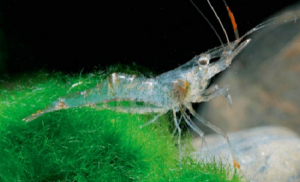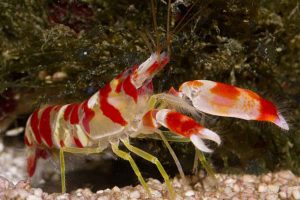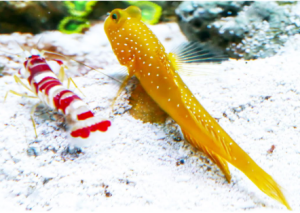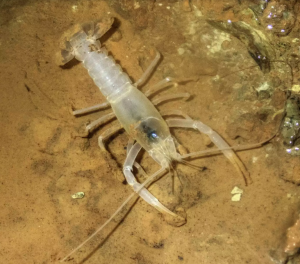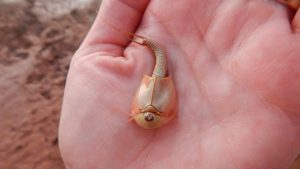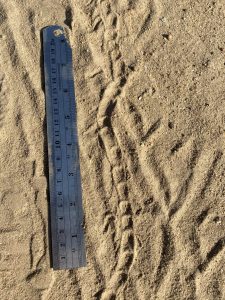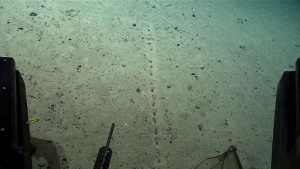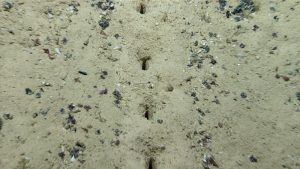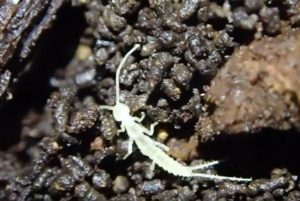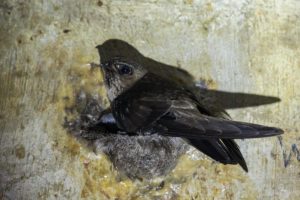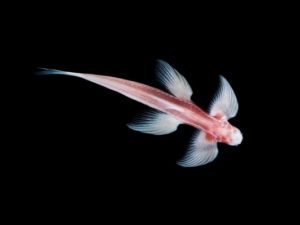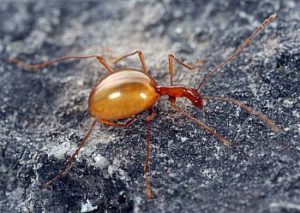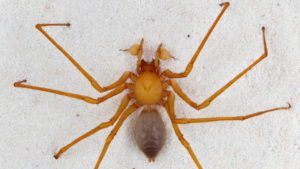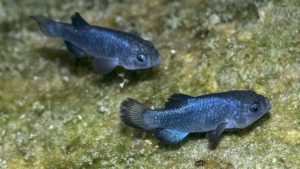Podcast: Play in new window | Download (Duration: 16:03 — 19.0MB)
Let’s look at some of the most interesting animals discovered last year!
Further reading:
Newly-discovered ‘margarita snails’ from the Florida Keys are bright lemon-yellow
Tiny spirits roam the corals of Japan—two new pygmy squids discovered
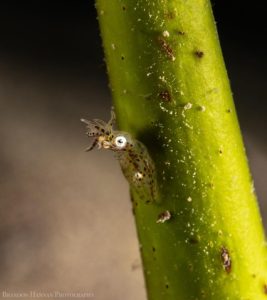
Strange New Species of Aquifer-Dwelling Catfish Discovered in India

Bizarre New Species of Catfish Discovered in South America
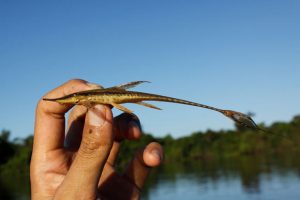
Unicorn-like blind fish discovered in dark waters deep in Chinese cave
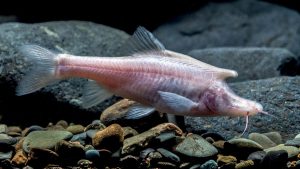
New Species of Hornshark Discovered off Australia

Cryptic New Bird Species Identified in Panama

New Species of Forest Hedgehog Discovered in China
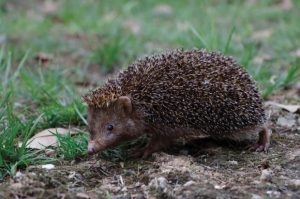
New species of voiceless frog discovered in Tanzania
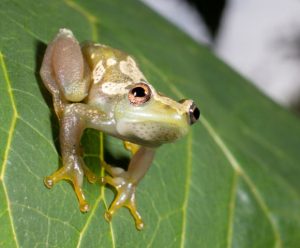
The weird new spiny katydid:
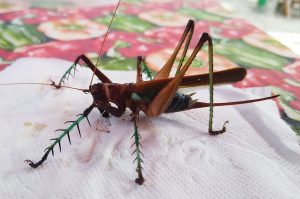
Show transcript:
Welcome to Strange Animals Podcast. I’m your host, Kate Shaw.
It’s time for our annual discoveries episode, where we learn about some animals discovered in the previous year! There are always lots more animals discovered than we have time to talk about, so I just choose the ones that interest me the most.
That includes the cheerfullest of springtime-looking marine snails discovered in the Florida Keys. The Florida Keys are a group of tropical islands along a coral reef off the coast of Florida, which is in North America. A related snail was also discovered off the coast of Belize in Central America that looks so similar that at first the scientists thought they were the same species with slightly different coloration. A genetic study of the snails revealed that they were separate species. The one found in the Keys is a lemony yellow color while the one from Belize is more of a lime green.
The snails have been placed into a new genus but belong to a group called worm snails. When a young worm snail finds a good spot to live, it sticks its shell to a rock or other surface and stays there for the rest of its life. Its shell isn’t shaped like an ordinary snail shell but instead grows long and sort of curved or curly. The snail spreads a thin layer of slime around it using two little tentacles, and the slime traps tiny pieces of food that float by.
The new snails are small and while the snail’s body is brightly colored, its shell is drab and helps it blend in with the background. Scientists think that the colorful body may be a warning to potential predators, since its mucus contains toxins. It mainly lives on pieces of dead coral.
Another invertebrate discovery last year came from Japan, where two new species of pygmy squid were found living in seagrass beds and coral reefs. Both are tiny, only 12 mm long, and are named after little forest spirits from folklore. Despite its small size, it can eat shrimp bigger than it is by grabbing it with its little bitty adorable arms. Both species have been seen before but never studied until now. The scientists teamed up with underwater photographers to find the squid and learn more about them in their natural habitats.
As for invertebrates that live on land, an insect called the blue-legged predatory katydid was discovered in the rainforests of Brazil. It’s a type of bush-cricket that’s dark brown in color except for the last section of its legs, which are greenish-blue. Those parts of its legs are also really spiny. That is literally all I know about it except for its scientific name, Listroscelis cyanotibiatus, but it’s awesome.
Let’s leave the world of invertebrates behind and look at some fish next. This was the year of the catfish, with new species discovered in both India and South America. Catfish can be really weird in general and both these new species are pretty strange.
The first is tiny, only 35 mm long at most, or a little over an inch, and it has four pairs of barbels growing from its face. It looks red because its blood shows through its skin, because its skin doesn’t have any pigment. The fish also doesn’t have any eyes. If this makes you think it’s a cave-dwelling fish, you’re exactly right, but instead of an ordinary cave it actually lives in an aquifer.
An aquifer is a source of water underground. It’s actually a layer of rock that’s broken up or otherwise permeable so that water can get through it, but with a non-permeable layer underneath. The water is trapped in the layer, sometimes far underground. If you’ve ever seen a spring, where water bubbles up from the ground, that water comes from an aquifer that has found its way to the surface. If you’ve ever drunk water pumped or dipped up from a well, the well-water also comes from an aquifer. The water gets into the aquifer in the first place when rain soaks into the ground, but it takes a long time to fill up.
There are really deep aquifers that are completely sealed off from the surface, created thousands or even millions of years ago. As far as we know, nothing lives in those, although we could be wrong. Aquifers that are closer to the surface with some surface openings develop unique ecosystems, including animals that are found nowhere else on earth. That’s the case with the tiny red catfish found in the state of Kerala in India.
Scientists asked people in the area to watch out for any unusual animals when they had a new well dug or cleaned, and before long people from four towns reported finding the little red fish. Three other related species had previously been found in the state.
On the other side of the world, in South America, a much different type of catfish was discovered in Bolivia and Brazil. This one is an armored catfish, and the male actually grows short dermal teeth on the sides of his head that he uses to fight other males. Dermal teeth are teeth that grow on the skin instead of in the mouth, and it’s surprisingly common in fish, especially armored catfish.
The new catfish has been named Sturisoma reisi and it grows about 8 inches long, or 20 cm. It’s actually been known to scientists for a long time, but until recently no one realized it wasn’t one of five other catfish in the genus Sturisoma. They all look kind of similar. It’s a slender, active catfish with a long tail and a pointy rostrum that lives in swift-moving rivers. It was actually described in 2022, not 2023, but I only just realized I have the wrong year so let’s just move along quickly to another fish.
This one isn’t a catfish but it looks like one at first glance since it has barbels around its mouth. These are the whisker-like feelers that give the catfish its name. The newly discovered fish needs feelers because it doesn’t have working eyes, and it also doesn’t have scales or pigment in its skin. It was found in a cave in China, and in fact it’s only been found in a single pool of water in a single cave. The pool is only about 6 feet across, or 1.8 meters, and about two and a half feet deep, or 80 cm, but it’s home to a perfectly healthy population of fish. The fish grow about 5 inches long on average, or 13 cm.
The fish is a new member of the genus Sinocyclocheilus, and of the 76 known species in the genus, most live in caves. The new fish has been named S. longicornus because of a structure on its head that kind of looks like a unicorn horn, if the unicorn was a pink cave fish and its horn was shaped sort of like the tip of a ballpoint pen, also called a biro.
Some other species in this genus also have a so-called horn, although the new fish’s is larger than most. It juts forward and extends above what we can describe as the fish’s forehead. Scientists have absolutely no idea what it’s for. Since the fish can’t see, it can’t be to attract a mate. It’s also not likely to be a navigational aide since the fish has its barbels and a well-developed lateral line system to find its way around. Besides, it lives in a pool of water not much bigger than the desk I’m sitting at. It doesn’t exactly travel very far throughout its life.
Scientists have a lot of other questions about the fish, including how it survives in such a tiny pool of water.
Speaking of fish with horns, a new species of hornshark was discovered last year off the northern coast of Australia. Hornsharks live in shallow warm waters throughout much of the Pacific and Indian oceans, where they spend most of the time at the bottom looking for small invertebrates like crustaceans to crunch up, although sea urchins are their favorites. They’re also called bullhead sharks because they all have short snouts and broad heads with prominent brows. The name hornshark comes from the fins, some of which have spines.
One species of hornshark is the zebra hornshark, which lives in the Indo-Pacific, from southern Japan down to northern Australia. As you may guess from the name, it has stripes, which makes it popular in aquariums and zoos. It only grows to about 4 feet long, or 1.25 meters. Until last year, scientists thought that all the zebra hornsharks around Australia belonged to the same species. Then they noticed that one population that lives off of northwestern Australia has a different stripe pattern and only grows about two feet long, or 60 cm. After a genetic study, it turns out that it’s a totally different species.
A lot of animal discoveries are like this, where everyone thinks an animal is one species, but after close study and genetic testing they find out it’s two or more species that just look very similar. That’s one of the great things about DNA testing being so effective and quick these days, but it’s not always as cut and dried as it sounds. There’s no easy way to determine for sure if animals are different species, subspecies, or just the same species with population variants. Scientists can’t just rely on genetics, but they also can’t always rely on observations of the animal’s physical traits or its behavior in the wild. They have to look at all the data available, and then they still argue about the best interpretation of the data.
The notion of a separate species or subspecies is an artificial one that gives us a way to better understand a natural process. If a population of animals is separated from another population, eventually both will develop separately until they’re two related but very different animals. There’s no way to point at a specific generation and say, “well, NOW they’re different from the last generation” because the process is so slow and the changes are usually so small. It’s like looking at a rainbow and trying to determine exactly the point where red turns into orange and orange turns into yellow.
Take the slaty-backed nightingale-thrush as an example. It’s a dark gray songbird with a short tail and bright orange legs and beak, and it lives in the mountains of Central and northern South America. It spends most of its time in thickets where it’s hard to see but easy to hear, since it has a lovely song. This is an example of what it sounds like, although its song varies depending on where it lives.
[bird song]
It turns out that there’s a lot of variation in the bird’s song because the slaty-backed nightingale-thrush probably isn’t all one species. In late 2023 a team of researchers published a ten-year study of the bird, looking at everything from song variations to genetics. They determined that not only was it not a single species, it was most likely seven different species and four subspecies. Because the bird lives in the mountains and doesn’t fly very far during its lifetime, populations that are separated by steep mountains and valleys have developed into separate species.
Naturally, not everyone agrees with these findings, but it’s always good when a little-studied animal gets some attention. Until last year, no one knew much about this shy little bird, and the controversy of whether it’s one species or lots of closely related species will hopefully lead us to learn even more about it. One population of the bird discovered in Panama had never been documented before, too.
This episode is getting pretty long for someone who just got over a cold, so let’s cover one newly discovered mammal and a newly discovered frog. A new species of forest hedgehog was discovered in China last year and it’s adorable! It’s related to the hedgehogs found in Europe and other areas, but is most closely related to four known species of forest hedgehog that live mostly in central Asia. The new species was discovered in eastern China, over 1,000 km away from the nearest population of other forest hedgehogs. Another species was only discovered in 2007 from southwestern China.
Unlike most hedgehogs, the new species is sexually dimorphic, meaning that males and females don’t look identical. Males are mostly gray while females are more reddish-brown in color.
Let’s finish with another adorable animal, a little frog from Tanzania, a country in east Africa. It’s a type of spiny-throated reed frog, which are all rare and increasingly threatened. They’re also very small, not much bigger than an inch long, or about 30 mm. The male has tiny little spines on his throat that researchers think might be a way that females recognize the males of their own species during mating season instead of by a distinctive croaking sound. That’s because spiny-throated reed frogs can’t make sounds, leading to their other common name of the voiceless frog.
In 2019, researchers were in the Ukaguru Mountains in Tanzania looking for a completely different frog, the beautiful tree toad, which may be extinct. While they didn’t find any of the toads, they did find a little greenish-brown frog with copper-colored eyes that turned out to be completely new to science. It was found in a nature reserve and appears to be common locally, which is good, but the nature reserve is also very small, which is not so good. Hopefully now that we know the little frog exists, it will lead to further protections of the area that will help all the other animals and plants where it lives, including the beautiful tree toad.
This is what the voiceless frog sounds like:
[silence]
You can find Strange Animals Podcast at strangeanimalspodcast.blubrry.net. That’s blueberry without any E’s. If you have questions, comments, or suggestions for future episodes, email us at strangeanimalspodcast@gmail.com. We also have a Patreon at patreon.com/strangeanimalspodcast if you’d like to support us for as little as one dollar a month and get monthly bonus episodes.
Thanks for listening!
